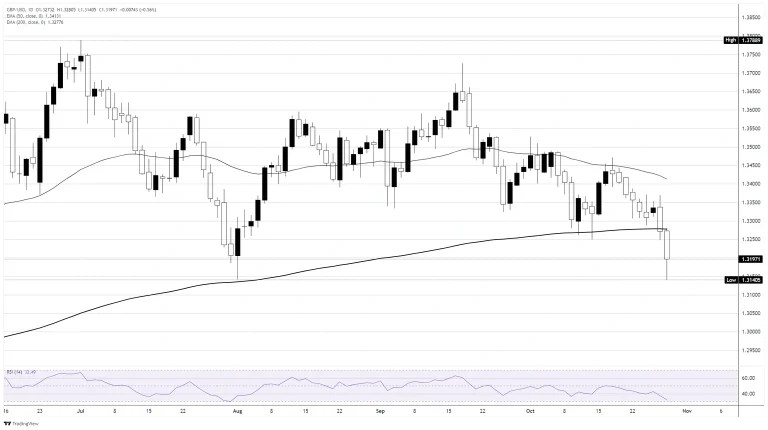At a Glance
- GBP/USD experienced a significant decline, dropping below the 200-day Exponential Moving Average and entering bearish territory.
- The US Federal Reserve reduced its benchmark interest rate by 25 basis points as anticipated, but Federal Reserve Chair Jerome Powell’s cautious tone during the press conference surprised markets.
- Expectations for further interest rate cuts in December have diminished significantly due to the Fed’s cautious stance and the impact of the US government shutdown on data availability.
- Rate traders are now pricing in a lower probability for a December rate cut, pushing potential future cuts into 2026.
GBP/USD Faces Steep Decline
GBP/USD saw a sharp fall during Wednesday’s American market session, continuing its downward trend past the 200-day Exponential Moving Average (EMA). This move pushed the Cable positioning even deeper into bear market territory. The pair has closed lower for eight of the last nine trading days, representing a significant 2.46% swing for the Pound Sterling (GBP) against the US Dollar (USD).
💡 The Federal Reserve (Fed) implemented a 25 basis point cut to its main reference rate on Wednesday, an outcome largely expected by market participants.
What caught investors by surprise was the press conference held by Fed Chair Jerome Powell, which conveyed a more cautious outlook than usual. Prior to this week’s Fed interest rate decision, investors were confident that an October rate cut would be followed by a similar reduction in December. However, the sentiment has shifted, suggesting that interest rate cuts in the latter half of 2025 might be limited or even concluded.
📊 Citing a lack of comprehensive official economic data due to the ongoing US government shutdown, Fed Chair Powell indicated that the Federal Reserve might be compelled to adopt a wait-and-see approach.
This potential for another data cycle without clear direction on rate cuts from the Fed has led investors to significantly scale back their expectations for a third rate cut in December. Currently, rate traders are assigning a probability of less than 33% for a rate trim on December 10th, with hopes for another reduction now pushed back to January 2026.
Understanding the Pound Sterling
Pound Sterling FAQs
The Pound Sterling (GBP) is recognized as the world’s oldest currency, originating in 886 AD, and serves as the official currency of the United Kingdom. It holds the position of the fourth most traded currency globally, accounting for approximately 12% of all foreign exchange (FX) transactions, with an average daily volume of $630 billion based on 2022 data. Its primary trading pairs include GBP/USD, commonly known as ‘Cable,’ which constitutes 11% of FX volume, GBP/JPY or ‘Dragon’ (3%), and EUR/GBP (2%). The Bank of England (BoE) is the issuing authority for the Pound Sterling.
The monetary policy decisions made by the Bank of England (BoE) are the most critical factor influencing the value of the Pound Sterling. The BoE bases its decisions on its primary objective of achieving price stability, which translates to maintaining a steady inflation rate around 2%. Its principal instrument for managing inflation is the adjustment of interest rates. When inflation is elevated, the BoE typically raises interest rates to curb borrowing costs, making credit more expensive for individuals and businesses. This action is generally beneficial for GBP, as higher interest rates make the UK a more attractive destination for global investors seeking returns. Conversely, when inflation dips too low, signaling a potential economic slowdown, the BoE may consider lowering interest rates to stimulate borrowing and encourage investment in growth-oriented projects.
Economic data releases provide crucial insights into the health of an economy and can significantly impact the value of the Pound Sterling. Key indicators such as Gross Domestic Product (GDP), Manufacturing and Services Purchasing Managers’ Indexes (PMIs), and employment figures all play a role in shaping GBP’s direction. A robust economy tends to boost Sterling, not only by attracting foreign investment but also by potentially prompting the BoE to increase interest rates, which directly strengthens the currency. Conversely, weak economic data often leads to a decline in the Pound Sterling.
The Trade Balance is another significant data point for the Pound Sterling. This metric measures the difference between a country’s earnings from exports and its spending on imports over a specific period. If a country’s exports are in high demand globally, its currency tends to benefit from increased demand from foreign buyers. Consequently, a positive net Trade Balance strengthens a currency, while a negative balance typically weakens it.
Author’s Summary
The GBP/USD pair has experienced a substantial drop, falling below key technical levels and entering a bearish trend. This decline comes amidst shifting expectations for US Federal Reserve interest rate policy, influenced by cautious commentary from Fed Chair Jerome Powell and the impact of the government shutdown on economic data. Market sentiment has moved away from expectations of further rate cuts in the near term.

